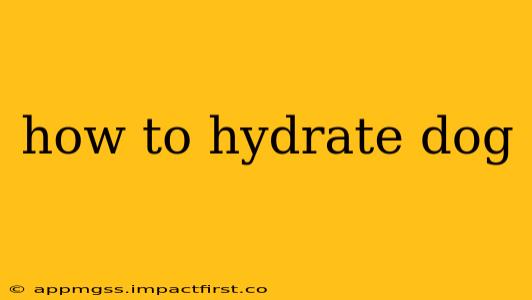Keeping your canine companion properly hydrated is crucial for their overall health and well-being. Dehydration can lead to serious health problems, so understanding how to ensure your dog drinks enough water is essential. This comprehensive guide will cover various aspects of canine hydration, answering common questions and offering practical tips.
How Much Water Should My Dog Drink?
The amount of water your dog needs depends on several factors, including their size, breed, activity level, age, and health condition. There's no single magic number. However, a good rule of thumb is to offer approximately one ounce of water per pound of body weight per day. A more active dog will naturally require more water. Observe your dog's water consumption; if they seem thirsty, increase their water intake. Also consider the weather – hot and humid days will necessitate more water.
What are the Signs of Dehydration in Dogs?
Recognizing the signs of dehydration is crucial for timely intervention. Look out for these symptoms:
- Dry gums: If your dog's gums feel sticky or dry instead of moist, this is a major warning sign.
- Sunken eyes: Dehydrated dogs often have eyes that appear sunken into their sockets.
- Loss of skin elasticity: Gently pinch the skin on the back of your dog's neck. If the skin remains tented (slow to return to its normal position), this indicates dehydration.
- Lethargy and weakness: Dehydration can cause your dog to become unusually tired and weak.
- Decreased urination: A significant reduction in the frequency or amount of urination is a clear sign of dehydration.
If you notice any of these symptoms, consult your veterinarian immediately.
What if My Dog Won't Drink Water?
Sometimes, dogs may refuse water due to various reasons. Here are some strategies to encourage hydration:
- Offer fresh, clean water: Ensure their water bowl is always filled with fresh, cool water. Regularly clean and disinfect the bowl to eliminate any unpleasant tastes or smells.
- Try different bowls: Some dogs prefer certain types of bowls. Experiment with different materials, shapes, and sizes to find one your dog likes. Elevated bowls can be helpful for dogs with arthritis.
- Add flavor to the water: A tiny splash of low-sodium broth (ensure it's dog-safe) or a few pieces of ice can make water more appealing. Avoid using sugary or artificial sweeteners.
- Provide water in multiple locations: Place water bowls in different areas of your home, especially if your dog spends time in different rooms.
- Wet food: Wet food provides additional hydration.
- Ice cubes: Frozen treats like ice cubes (or even frozen broth cubes) can be a fun way to increase water intake.
How Can I Tell if My Dog is Getting Enough Water?
Regularly monitor your dog's water intake and observe their overall health. Look for normal urination, moist gums, and energetic behavior. If you have any concerns, consult your veterinarian. They can assess your dog's hydration level through a physical exam and potentially through blood tests.
What Foods or Drinks Can Hydrate My Dog?
While water is the best source of hydration, some foods can contribute to their overall fluid intake. Wet food contains more moisture than dry kibble. Fruits and vegetables like watermelon (seedless), cucumber, and cantaloupe (in moderation) can also contribute to hydration. Never give your dog grapes or raisins, as these are toxic.
Can I Give My Dog Electrolytes?
Electrolyte drinks are usually only necessary if your dog is severely dehydrated or suffering from diarrhea or vomiting. Always consult your veterinarian before giving your dog any electrolytes, as an imbalance can be harmful. They will advise on the appropriate type and dosage.
This guide provides general information. Always consult your veterinarian for personalized advice regarding your dog's hydration needs, particularly if you have concerns about their health or water intake. Proactive hydration is key to keeping your furry friend happy and healthy!
